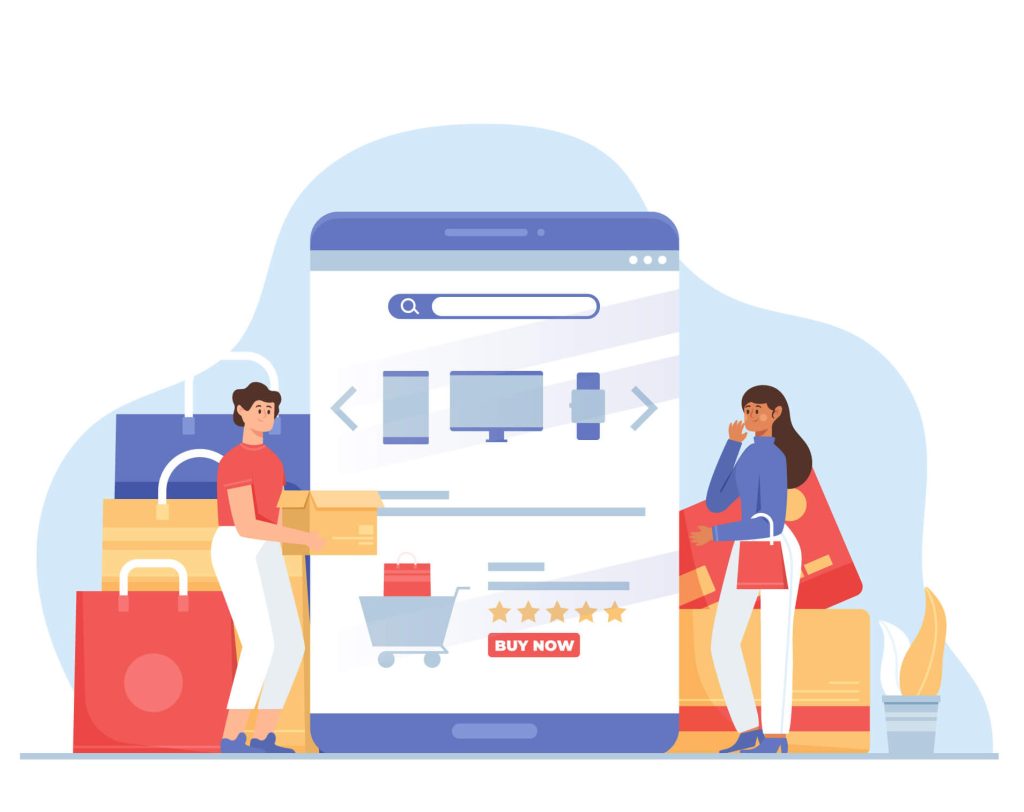Fly High Media can provide expertise and experience for your campaigns to help improve your ROI, save time, and stay up-to-date with the latest trends and strategies.
Matt Pyke
How to Boost Ecommerce Sales with Google Shopping

Google Shopping campaigns are a powerful tool for online retailers to showcase their products and drive sales.
However, running a successful Google Shopping campaign requires more than just setting it up and letting it run. You must continually optimise and refine your campaigns to maximise your return on investment (ROI).
In this blog post, we’ll share some of the best ways to improve your Google Shopping campaigns, including optimizing your product feed, using negative keywords, optimizing your bids, testing different ad formats, utilising campaign priorities, and using audience targeting.
By implementing these strategies, you can improve the performance of your Google Shopping campaigns and reach more potential customers who are interested in your products. So let’s dive in and explore how you can take your Google Shopping campaigns to the next level!
What is Google Shopping?

Google Shopping is an online platform where retailers can showcase their products to potential customers searching for them on Google. Online advertising allows retailers to display their product images, prices, and other details directly in Google’s search results.
When a user searches for a product on Google, they’ll see a list of products from various retailers that match their search query. These product listings are accompanied by images, prices, and other information, making it easy for users to compare and find the desired product.
Google Shopping uses a pay-per-click (PPC) model, meaning retailers only pay when users click on their product listing. Retailers can set their own bids for each product and compete with other retailers for ad placement.
What is the difference between Google Search and Shopping?
Google Search is the main search engine offered by Google. It allows users to search for anything they want, including websites, images, videos, and news articles. The search results for Google Search are typically displayed in a list format and include links to websites that match the user’s search query.
Google Shopping, on the other hand, is a specialised search engine that focuses on products and shopping. When a user searches for a product on Google Shopping, they’ll see a list of product listings from various retailers that match their search query. These product listings include images, prices, and other details, making it easy for users to compare products from different retailers.
While Google Search shows various content related to a search query, including websites and information, Google Shopping shows only product listings related to a search query. In other words, Google Shopping is more focused on ecommerce and helping users find products to buy.
In short, the key difference between Google Search and Google Shopping is that Google Search is a general search engine for all types of content, while Google Shopping is a specialised search engine focused specifically on products and shopping. If you’re an ecommerce business looking to sell products online, Google Shopping is a great platform to showcase your products to potential customers actively searching for them.
Steps to a profitable Google Shopping campaign:

1. Optimise your feed
Your product feed is the foundation of your Google Shopping campaign, as it contains all the information about your products that Google uses to show your ads. Therefore, optimising your product feed is crucial to ensure it accurately represents your products and meets Google’s requirements.
To optimise your product feed, you should start by ensuring that all the required attributes are included and accurately filled out, such as product ID, title, description, image link, price, and availability. Provide as much detail as possible about your products, including product features, specifications, and variations. Use high-quality product images that showcase your products in the best light possible.
It’s also essential to use relevant keywords in your product titles and descriptions, as these will help your products appear in relevant search queries. Be specific and descriptive in your titles, and use natural language that accurately describes your products.
Finally, regularly review and update your product feed to ensure it remains accurate and up-to-date. If you add new products or change existing ones, update your feed accordingly.
Optimising your product feed ensures that your products are accurately represented and more likely to appear in relevant search results. This can help drive more traffic and sales to your website.
2. Use negative keywords
Negative keywords are keywords that you don’t want your ads to show for. They allow you to filter out irrelevant search queries and ensure that your ads are only shown to users who are likely to be interested in your products. For example, if you sell high-end designer shoes, you might want to exclude keywords like “cheap,” “discount,” or “affordable” to avoid showing your ads to users looking for a bargain or low-priced shoes.
To use negative keywords effectively, start by reviewing your campaign data to identify search terms that trigger your ads but are irrelevant to your products. You can do this by reviewing your search term reports in Google Ads, which show the actual search terms that users typed in before seeing your ads.
Once you have identified irrelevant search terms, add them as negative keywords to your campaign or ad group. This will prevent your ads from showing for those search terms in the future. You can add negative keywords at the campaign or ad group level, depending on how specific you want to be.
Regularly review and update your negative keyword list to ensure you filter out irrelevant search terms and not inadvertently block relevant ones. Negative keywords can help you improve the relevancy of your ads, reduce wasted ad spend, and ultimately improve the performance of your Google Shopping campaigns.
3. Optimise your bids
Optimising your bids is critical to ensuring your ads are shown to the right audience at the right time. Your bid is the amount you’re willing to pay for a click on your ad, and it’s one of the key factors determining where and when your ads are shown.
To optimize your bids, review your campaign data to identify which products or product categories drive the most clicks, conversions, and revenue. You can use this information to adjust your bids accordingly, focusing more budget on your highest-performing products.
In addition, consider using bid adjustments to optimize your bids based on other factors, such as device type, location, and time of day. For example, if your ads perform better on mobile devices, you can increase your bids for mobile users to ensure that your ads are shown more often to this audience.
It’s also important to monitor your bids regularly and adjust them as needed based on the performance of your campaigns. You can use bid automation tools, such as Google’s Target ROAS or Target CPA bidding strategies, to help you automatically adjust your bids based on your desired return on ad spend or cost per acquisition.
By optimizing your bids, you can ensure that your ads are shown to the right audience at the right time, which can help improve the performance of your Google Shopping campaigns and drive more traffic and sales to your website.
4. Test different ad formats
Testing different ad formats is critical to improving your Google Shopping campaign. Google Shopping campaigns support several ad formats, each with unique benefits and drawbacks. By testing different ad formats, you can determine which ones work best for your products and audience and allocate your budget accordingly.
Standard Shopping ads are the most common type of Google Shopping ad format. They feature a product image, title, price, and store name and are shown to users based on their search queries. On the other hand, Showcase Shopping ads allow you to group related products together and showcase them in a branded ad unit. These ads are great for promoting a specific product line or category.
Product Shopping ads are similar to standard Shopping ads but feature a larger product image and can include additional details like ratings and reviews. These ads are ideal for products with high visual appeal, such as apparel or home decor.
By testing different ad formats, you can see which resonates best with your audience and generate the most clicks and conversions. You can also target users at different buying cycle stages in different ad formats. For example, Showcase Shopping ads may be more effective for users who are in the awareness or consideration stage, while Product Shopping ads may be more effective for users who are closer to making a purchase.
Testing different ad formats is essential to improving your Google Shopping campaign. By experimenting with different ad formats, you can identify the most effective format for your products and audience and optimize your campaign for maximum ROI.
5. Prioritise
Campaign priorities are an often-overlooked feature of Google Shopping campaigns that can significantly impact your campaign’s performance. By setting campaign priorities, you can control which campaigns are shown for a given search query, ensuring that your most relevant and high-performing campaigns are shown to the right users.
Campaign priorities work by assigning a priority level to each campaign in your account. Google Shopping will then show ads from campaigns with higher priority levels before those with lower priority levels. This is particularly useful when multiple campaigns target the same products or keywords but have different bid strategies, budgets, or targeting.
For example, suppose you have a standard Shopping campaign and a Product Shopping campaign that both target the same products but have different ad formats and bid strategies. By assigning a higher priority to the Product Shopping campaign, you can ensure that your ads are shown in the more visually appealing and attention-grabbing Product Shopping ad format for relevant search queries.
To set campaign priorities, navigate to your Google Shopping campaign’s “Settings” tab and click “Campaign priority.” Then select the appropriate priority level for your campaign, from “Low” to “High.” Remember that campaigns with higher priority levels will be shown before those with lower ones.
In summary, setting campaign priorities effectively ensures that your most relevant and high-performing campaigns are shown for the right search queries. By assigning a higher priority to campaigns with better performance or more relevant ad formats, you can optimize your Google Shopping campaign for maximum ROI.
6. Use audience targeting
Audience targeting allows you to show your ads to users based on their interests, behaviours, and demographics rather than just their search queries.
There are several types of audience targeting options available for Google Shopping campaigns, including:
Remarketing: Remarketing allows you to show ads to users who have visited your website or interacted with your products. These users are more likely to convert so that remarketing can drive more sales.
Similar Audiences: Similar Audiences are users who share similar interests and behaviours with your existing customers. By targeting these users, you can expand your reach to new potential customers likely to be interested in your products.
Demographic targeting: Demographic targeting allows you to show your ads to users based on age, gender, and other demographic factors. This can be useful if you have products targeted at specific age or gender groups.
In-Market audiences: In-Market audiences are users actively searching for products or services like yours. By targeting these users, you can reach users further along in the buying cycle and are more likely to convert.
By using audience targeting, you can reach more relevant users and improve the performance of your Google Shopping campaigns. To set up audience targeting, navigate to the “Audiences” tab of your Google Shopping campaign and select the appropriate targeting options for your campaign.
Audience targeting is a powerful tool for improving the performance of your Google Shopping campaigns. By targeting users based on their interests, behaviours, and demographics, you can expand your reach to new potential customers and drive more sales.
By implementing these strategies, you can improve the relevance and effectiveness of your Google Shopping campaigns, which can lead to increased sales and revenue for your ecommerce business.
If you would like to kickstart your journey to Google ad success then get in touch with Fly High Media today!
ROAS stands for Return on Advertising Spend. It is a metric used to measure the effectiveness of advertising campaigns by calculating the revenue generated compared to the amount spent on advertising.
ROAS is calculated by dividing the revenue generated by an advertising campaign by the cost of the campaign. For example, if you spent £1,000 on advertising and generated £5,000 in revenue, your ROAS would be x5 (£5,000/£1,000).
TROAS stands for Target Return on Ad Spend, a bid strategy in Google Ads that allows advertisers to set a specific ROAS target for their campaigns. Unlike other bid strategies that maximise conversions or clicks, the TROAS bid strategy focuses on achieving a specific ROAS goal.
With the TROAS bid strategy, advertisers can set a target ROAS percentage that they want to achieve for their campaigns. Google Ads will then use machine learning to automatically adjust bids for each auction in real-time to help achieve the target ROAS. This means that the bid strategy will adjust the bid amount higher or lower based on the likelihood of a click leading to a conversion that meets the target ROAS.
TROAS bid strategy is particularly useful for e-commerce businesses that have a specific profit margin they want to achieve for each sale. By setting a target ROAS, advertisers can ensure their advertising spend generates a certain profit level. The TROAS bid strategy can also adjust bids for different products based on their profit margins and performance.
To use Google Shopping, you need to have at least one product to advertise. There is no specific minimum or maximum number of products required to use Google Shopping. You can advertise as few or as many products as you like, depending on your business needs. However, it’s worth noting that Google Shopping is particularly effective for businesses that have a large inventory of products. This is because Google Shopping allows you to showcase your products to users who are actively searching for them, which can help drive targeted traffic and sales to your website.
Google Shopping feed optimisation is an ongoing process, and the timeline for optimisation varies based on factors such as the size of your product catalogue and the complexity of your campaigns. There is no fixed time frame as it depends on individual circumstances, and ongoing adjustments are needed to ensure optimal performance.
To increase your CTR in Shopping ads, you can improve the relevance and quality of your product feed, use high-quality product images, optimise your product titles and descriptions, use negative keywords to exclude irrelevant search terms, and adjust your bids and targeting to reach your ideal audience.
The ranking factors for Google Shopping include bid amount, product relevance, product data quality, expected clickthrough rate, and landing page experience.
Contact Us
Cheshire (Head Office)
Manchester
Get in touch
Let’s find the best solution for your business
